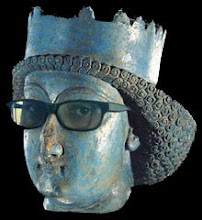
Did you know that it was the evil Gargamel who created Smurfette? His plan was to send this beautiful (and easily manipulated) creature into the midst of the hated smurfs and follow her to find their secret village. It worked too. She led evil straight into the smurf village under the guise of friendship and acceptance.
Sounds a little too familiar.
Isn't this exactly the claim of those who would oppose the ordination of women? Don't they think that it would be introducing an evil element into a sacred office? I am not saying they would think women are "evil" per se, but the fear is that the wrong gender can contaminate the holy role of the priest/pastor.
As it turns out, Smurfette ends up saving the entire village from Gargamel. And her unique perspective on the "evil one" adds a whole new level of protection for the smurfs.
The Church desperately needs this new perspective right now. For too long we have limited ourselves. For too long we have only been half complete. Now is the time to break away from this trammel. I am so glad to be a member of a denomination (PCUSA) that celebrates fullness in our ordained ministers and elders and deacons. I congratulate the Episcopal and Anglican churches for their recent (within the last 20 years all the way up to a few weeks ago) steps forward. There are many other Christian churches that celebrate the fact that, "The same Spirit... calls women and men to all ministries of the Church" (Book of Confessions 10.4) like the UCC, UMC, etc. I pray for my brothers and sisters of the SBC, RCC, EO (Russian, Greek, etc.) that they may one day experience the fullness of what their clergy could be.
Let us not limit what God can do through those who are not male. Better yet, let's not define people by what they aren't, but let's know them by what they offer.
I'd like to end with this poem by Frances Croake Frank:
Did the woman say,
When she held him for the first time in the dark
of a stable,
After the pain and the bleeding and the crying,
"This is my body, this is my blood"?
Did the woman say,
When she held him for the last time in the dark rain
on a hilltop,
After the pain and the bleeding and the dying,
"This is my body, this is my blood"?
Well, that she said it to him then,
For dry old men,
brocaded robes belying barrenness,
Ordain that she not say it for him now.


3 comments:
What is the theological basis? I understand we should do this because churches need this, but what is the precedent? What did Christ do and what has the Church done since?
Women are obviously not evil. What does that have to do with them being ordained? Many folks do not think women should be ordained, but do not believe they are evil.
Take care,
MC
The theological basis is that women held prominent roles in the very beginning of the church (some would even argue they were bishops). The church, as it became more and more hellenized, did away with women bishops. Women deacons managed to hang around for a little longer but were eventually done away with as well.
Read any medieval theologian and you will see the pervasive idea of women being more associated with "flesh" and therefore not able to be as spiritual as men. This was part of the argument for men being spiritual leaders because women could not lead themselves. It was also used to condemn married priests because they were attached to women.
The folks who are against women's ordination might not vocalize in the same way their reasons, but they grow out of these distorted views of women.
You ask what did Jesus do. Well, He had as His first messengers after the resurrection... women. He sent women out to preach (and thus represent Him). He had women disciples. He got the ball rolling... but just a few years later His church stopped that particular ball.
Theologically again, God is neither male nor female. Sure, the male imagery is predominant throughout scripture (let's think about who wrote it) but there is female imagery for God AND Jesus. In Isaiah, God is spoken of as a mother nursing Israel at Her breast. Jesus talks of being a mother hen gathering Her chicks. Paul speaks of Jesus as the "Wisdom" of God (the word for wisdom both in the Hebrew and Greek is feminine... "Sophia"). Humanity was created in God's image... male and female. If the priest/pastor is standing in God's place before the congregation (some protestants don't believe this but that is the Catholic, Orthodox, Anglican, Episcopalian, Lutheran, as well as some Methodist and Presbyterian view), and women are not permitted to perform this function, then we only get half of God. The church is denied experiencing a full representation of God.
Paul himself says there is neither male nor female in Christ. Peter speaks of the priesthood of ALL believers. Again, in the early church we see women in high positions (most likely as bishops... certainly as elders or presbyters). The original practice was changed.
I know that consciously, those who oppose women's ordination don't think them evil, but the women who are denied this (especially those who truly feel a call to it) are left with that assumption. It was the medieval theological stance and has been passed on to today.
Thanks! I will look into this and let you know what I find. If I have more questions I will ask.
This blog and the fact you're in school are pretty exciting to me. I was praying for you tonight that school would help you to spread the Gospel even more effectively.
Peace and all good!
-MC
Post a Comment